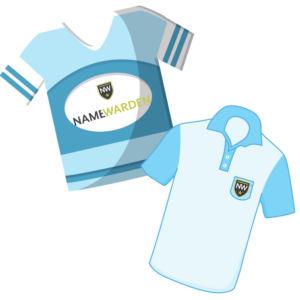Merely Ornamental? When a Decoration Is Not a Brand
‘Tis the season for merchandising! Your house, office, and yard may be full of holiday ornamentation but trademark applicants beware. If something is deemed to be “merely ornamental,” that’s grounds for the USPTO to refuse your application to register your mark.
Ornamentation is an issue that trips up a lot of applicants, especially for t-shirts, coffee mugs, bumper stickers, and other printable merchandise. The issue comes down to whether the wording or logo is being used as a trademark.
“Merely Ornamental” Refusal 
A “merely ornamental” refusal happens when the USPTO refuses registration because the sample, or “specimen” is deemed merely as an “ornamental or decorative feature” on the goods rather than as a trademark to indicate the source of goods.
The basic concept here is this: just because you have shirts made up with your logo on it does not make you an apparel company. Say for example Name Warden had shirts made to go to a conference. Because Name Warden is not a t-shirt company, the mark on the shirt is merely ornamental. We have not become an apparel company, so would not be able to get our mark registered in Class 25 for apparel.
Trademarks have to do with the brand of a product and its maker, and the real point of reference is not the front of the shirt but inside the back collar or on a tag hanging off of the sleeve. The size, location, dominance, and significance of your mark as applied to the goods are all factors in the USPTO’s determination of whether your mark functions as a trademark.
If, for example, you used a small insignia or shape on the breast pocket of your shirts, that could be considered a trademark because it creates the “commercial impression” of a trademark. If that same symbol was enlarged and placed across the front of the shirt, it could be considered ornamental.
How to Avoid a Refusal
The USPTO will refuse your mark if it is deemed merely ornamental or decorative. In their words, “when use of your mark does not clearly identify the source of your goods and distinguish them from the goods of others,” the mark is considered ornamental.
Examples of Ornamental use include:
- A quote across the front of a t-shirt
- An image on the main surface of a shirt, hat, or bag
- Embroidery embellishments
- Floral patterns
- Everyday expressions or symbols
Remember, it’s all about the mark being perceived as an identifying mark of the manufacturer.
Quick tips
- Consider the placement of your mark. Location plays a huge factor in the USPTO’s decision. Pockets, breast areas, and tags are places where trademark use is expected.
- Size and dominance of the mark matters. Small wording or design features are usually an indication of a brand mark and not decoration.
What to do when it happens
If you receive an Ornamental refusal, all hope is not lost. You can use the Trademark Electronic Application System (TEAS) to respond in either a Non-final Office action or a Final Office action.
You can also submit a substitute specimen – basically an example of the product in a different, non-ornamental form. Here’s the thing: you need to be able to prove that the substitute specimen(s) “was/were in use in commerce at least as early as the filing date of the application, prior to the filing of the amendment to allege use, or prior to the expiration of the filing deadline for a statement of use,” according to the USPTO.
The bottom line is when it comes to trademarking consumer goods, it’s not about design or content, it’s about branding of the company that makes the goods. The mark needs to identify the manufacturer of the product, not boldly display a logo or design. If you’re a t-shirt manufacturer, add your mark to the tag, pocket, or other brand-communicating location. If you’re a trademark docketing and defense service, slapping your logo on a shirt does not make you an apparel company. And, if you have trademarks to file, don’t do it the hard way. Use Name Warden to automatically file, register, and monitor your marks.
